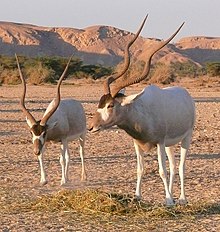Yotvata Hai-Bar Nature Reserve



The Yotvata Hai-Bar Nature Reserve is a 3,000-acre (12 km2) breeding and reacclimation center administered by the Israel Nature Reserves & National Parks Authority, situated in the Southern Arava near Yotvata.
The Yotvata Hai-Bar is the desert counterpart of the Carmel Hai-Bar Nature Reserve which operates in the country's Northern Mediterranean forest.[1]
Endangered and locally extinct animals mentioned in the Bible are bred here for possible reintroduction to the Negev desert. The Asian wild ass has already been reintroduced in the Makhtesh Ramon area of the wild, while the Arabian oryx has been reintroduced to the northern Arava.[2][3] In addition the park has some rare desert animals, which are not native to Israel, like the scimitar oryx and the North African ostrich.[1]
Some of the species bred here are:
- Arabian oryx (Oryx leucoryx)[1][4]
- Scimitar oryx (Oryx dammah)[1]
- Red-necked ostrich (Struthio camelus camelus)[1][4]
- Addax (Addax nasomaculatus)[1][4]
- Asian wild ass (hybrids of Equus hemionus kulan and Equus hemionus onager)[1][4]
- Somali wild ass (Equus africanus somaliensis)[1][4]
- Dorcas gazelle (Gazella dorcas)[1][5]
- Arabian gazelle (Gazella arabica)[1][6]
- Griffon vulture (Gyps fulvus)[1]
- Caracal (Caracal caracal schmitzi)
- Arabian sand cat (Felis margarita harrisoni)
- Arabian leopard (Panthera pardus nimr)
- South African cheetah (Acinonyx jubatus jubatus)
- Arabian wolf (Canis lupus arabs)
- Nubian ibex (Capra nubiana)[7]
- Persian leopard (Panthera pardus tulliana)
- Striped hyena (Hyaena hyaena)
References[edit]
- ^ a b c d e f g h i j k "Hai-Bar Yotvata Nature Reserve". Israel Nature and Parks Authority. Retrieved 2023-05-16.
- ^ Saltz, David; Rubenstein, Daniel I. (May 1995). "Population Dynamics of a Reintroduced Asiatic Wild Ass (Equus Hemionus) Herd". Ecological Applications. 5 (2): 327–335. doi:10.2307/1942025. JSTOR 1942025.
- ^ Gilad, Oranit; Grant, William E.; Saltz, David (2008-01-10). "Simulated dynamics of Arabian Oryx (Oryx leucoryx) in the Israeli Negev: Effects of migration corridors and post-reintroduction changes in natality on population viability". Ecological Modelling. 210 (1): 169–178. doi:10.1016/j.ecolmodel.2007.07.015. ISSN 0304-3800.
- ^ a b c d e Rohner, Christoph; Ward, David (October 1997). "Chemical and mechanical defense against herbivory in two sympatric species of desert Acacia". Journal of Vegetation Science. 8 (5): 717–726. doi:10.2307/3237377. JSTOR 3237377.
- ^ Baharav, Dan (1980-06-01). "Habitat utilization of the dorcas gazelle in a desert saline area". Journal of Arid Environments. 3 (2): 161–167. Bibcode:1980JArEn...3..161B. doi:10.1016/S0140-1963(18)31664-1. ISSN 0140-1963.
- ^ Breslau, Benjamin; Polak, Tal; Shalmon, Benny; Groner, Elli (2020-02-01). "Evidence of browsing pressure on the critically endangered Acacia gazelle (Gazella acaciae)". Journal of Arid Environments. 173: 104019. Bibcode:2020JArEn.173j4019B. doi:10.1016/j.jaridenv.2019.104019. ISSN 0140-1963. S2CID 203405255.
- ^ Putnam, Andrea S.; Nguyen, Tram N.; Mott, Alison; Korody, Marisa L.; Ryder, Oliver A. (March 2020). "Assessing possible hybridization among managed Nubian ibex in North America". Zoo Biology. 39 (2): 121–128. doi:10.1002/zoo.21527. ISSN 0733-3188. PMID 31833594. S2CID 209340970.
External links[edit]
- Yotvata Hai-Bar on the website of the Israel Nature and Parks Authority
- Photos and videos from Hai-Bar Yotvata, Flickr
- Yotvata Hai Bar Image Gallery
29°52′17″N 35°03′01″E / 29.871406°N 35.050292°E
